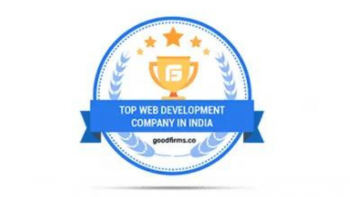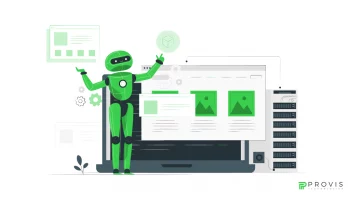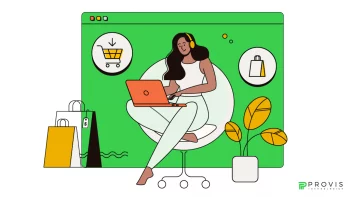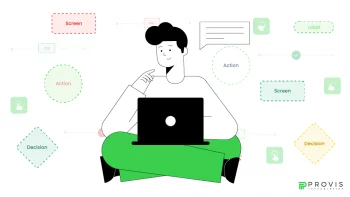You have a bright idea for a SaaS (Software as a Service) business and you don’t know how to code. You don’t have a background in software development, and learning programming languages looks like one big impossible task. Does that mean you have to say goodbye to your dream of starting a SaaS business? Absolutely not.
Most SaaS founders who were successful started with no (or minimal) technical experience. Using their SaaS business sense, problem-solving talents, and strategic partnerships, they brought their vision to life. Starting a SaaS business is entirely possible, even without coding skills, as long as you focus on the right strategies and find the right support.
To build a SaaS company, you don’t necessarily have to write a single line of code as long as you have an idea that solves a real problem. Using this Provis Technologies guide, you’ll see exactly what to do to accomplish that.
Step 1: Validate Your SaaS Idea
Make sure your idea is viable before you spend the time and money.
The most successful SaaS products are the ones that address real painful problems that your business or customer needs to solve every day.
Conducting market research is crucial. However, to find out whether people are willing to pay for your solution, talk to potential users, analyze the market, and test.
One thing to validate your idea is by interviewing your potential customer, or by conducting surveys and launching a pre-sales campaign with a landing page explaining your product.
Studying other SaaS businesses in the industry helps you find gaps in the market that your product can help you fill.
Step 2: Explore No-Code and Low-Code Solutions
It’s ancient history when building software was dependent upon complex hardwiring coding expertise. Today, non-technical founders can create fully functional SaaS products via no and low-code platforms.
With no-code platforms, you build visually using a drag-and-drop tool, and with low-code platforms, you get more customization with less coding.
In case your SaaS product is way more complex than no-code solutions can cope with, you may need to integrate low-code tools or look for partial development support. Moreover, using no-code tools and APIs together, you can even prototype an MVP with considerably lower cost & timeline.
Step 3: Outsource Development Work
When you’re building a SaaS startup that needs more than the no-code capabilities, outsourcing development is a smart thing to do.
Building your product does not require a full-time, in-house development team. Don’t worry about learning to code if you want to develop something. You can hire experienced freelancers or work with a development agency that specializes in your vision.
When outsourcing, ensure that you focus on getting the person based on experience and portfolio, not just cost. This is because, with low-cost developers, your code quality can suffer, leading to mishappenings in the future. As a result, it will cost you some extra money to undo the damage.
Finally, communicate with developers on what functionality, user flow, and key features your product should have. Project management tools allow for a clear and transparent development process to be maintained.
Furthermore, by launching an MVP, you will be able to launch a minimal version of your product. This will help you to get a feel for the market demand and then spend your finances on more advanced features.
Step 4: Develop a Sustainable Business Model
A good revenue for your SaaS business model is a must. Common pricing strategies include:
- Subscription-Based Model – The user pays monthly or annually to have access to your software.
- Freemium Model – A free version with the rest for a premium.
- Pay-Per-Use Model – Charged on the basis of usage level.
- Enterprise Licensing – Larger companies pay a fixed price for multiple users across an enterprise.
The right pricing strategy will depend on who your market is and how much your product is worth. One idea is to run free trials to entice users and show them the value of your SaaS business idea offering.
Step 5: Build a Strong Brand and Marketing Strategy
It’s not enough to have a great SaaS product; you have to build an inspiring brand and run a solid marketing campaign.
The takeaway is that your website should clearly explain what your software can do. Moreover, the design should be professional and user-friendly, where easy navigation and clear Call To Action buttons must appear.
Content marketing is an effective means of pulling in and educating potential customers. You can create guides, publish case studies, and write blog posts that can improve SEO rankings and build SaaS credibility. Also, optimizing your site for search engines drives more organic traffic, which means it will be easier for potential customers actually to find you.
At the same time, valuable insights can be shared on platforms like LinkedIn, Twitter, and YouTube with potential customers. For email marketing, it’s also important to nurture leads and convert them to users. Along with this, personalized emails boosting SaaS business products help improve conversion rates.
You can also run ads if you can invest in boosting search engines or social media presence.
Step 6: Provide Excellent Customer Support To Start SaaS
Retaining customers is more important than acquiring them. If you fail to satisfy your customers, they stop subscribing to our SaaS product and take diverse alternatives instead.
Customer support is also crucial because it improves the user experience and reduces churn rates.
Build services that help the user be as good as possible, offer them live chat, a ticketing system, and a detailed knowledge base.
Responding to customer queries immediately and offering real solutions to their pain points is a must for a sustainable SaaS business. Customer feedback helps you collect what you need to improve your product.
Keeping your product relevant and competitive requires you to update your software based on user feedback regularly. Moreover, the smartest SaaS companies started with a very basic version and added features based on what customers needed.
Also, as you grow, you are able to monitor the trends in the industry and what is happening in terms of technological advancements.
The Bottom Line
It’s perfectly possible to build a successful SaaS business without technical expertise. If your SaaS vision hasn’t become a reality yet, validating your idea, using no-code tools, outsourcing (when necessary), and a strong business and marketing strategy will help you realize your vision.
But the trick to SaaS for beginners by doing things more narrowly: get your MVP out, prove your market demand, and iterate your product with real user feedback. A tremendous number of non-technical founders have built SaaS success by focusing on execution, customer needs, and continuous improvement. Your SaaS journey starts today!
Written By
Author's Picks
- What is B2B Commerce?
- 13/11/2024
- AI-Powered Predictive Analysis: What It Means for E-commerce Development
- 07/11/2024
- WooCommerce Features List: Must-Have Features for Growing Your Store
- 17/12/2024
Categories
- AI Integration
- AI Platforms
- Android App
- Angular
- API
- App
- app development
- App Idea
- App User Feedback
- Application
- Artificial Intelligence
- Audit Services
- Automotive Industry
- Awards and Recognition
- Business Consulting
- Business Website
- Chatbots
- CRM
- CRM for Financial Advisors
- Custom CRM
- Customer Service
- dashboard design
- Digital Business
- E-commerce
- EMR Integration
- Finance
- Financial Advisors
- Financial Advisors
- GIT
- Health Insurance
- IT Audit Services
- IT Consulting
- IT Strategies
- Laravel
- Lean Canvas
- Mobile App Development
- News Aggregator Site
- predictive analysis
- Product Launch Strategy
- Progressive Web App (PWA)
- Prototype
- Recommender Systems
- Ruby
- SaaS
- SaaS Application
- SaaS Business
- SaaS Company
- SaaS Development
- SaaS Product
- SaaS Project
- SEO
- Technology
- Tetradic Color Scheme
- Unit Testing
- User Flow
- Web Development
- website Maintenance Services
- Website Migration Service
- WordPress




